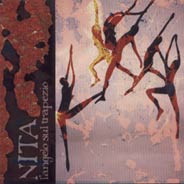Paolo
Angeli
Nita
- L'Angelo Sul Trapezio
(ReR)
It
was about two years ago that I reviewed here - quite favourably, by
the way - an album by Paolo Angeli called Bucato: a "solo"
album where the Italian musician played exclusively the "Sardinian
prepared guitar"; my two main points of dissatisfaction concerned:
first, the fact that the CD booklet lacked any real information about
this quite original instrument; then, that the CD was way too long,
a fact which diluted some beautiful moods, and which, besides, showed
the somewhat limited palette behind the musician's inspiration.
I
was curious about Angeli's evolution, and I had hoped for his solo dimension
to mature; so I was initially not-too-happy about the news that his
new CD would feature a wide, "orchestral" ensemble - a fact
that takes us back to his previous, and quite varied, musical experiences.
As soon as I had rearranged my listening expectations, everything was
alright.
But
many listening sessions, in the course of a whole week, failed to make
my initial perplexities disappear. I'll immediately say that a lot of
care went into this work, both at the arranging and at the recording/mixing
stage - all elements that make it very easy for the listener to appreciate
the beautiful colours of Angeli's orchestrations. The work of the musicians
in the ensemble is agile and technically competent - this is not the
kind of music that leaves a lot of space for solos, by the way, but
listeners will be able to find their favourite instrumental sounds inside
the palette. There's so much variety here that this (extremely good-sounding)
CD could easily work as nice background for listeners with cultivated
taste.
My
main reasons for puzzlement deal with two areas. The first is a certain
lack of personality at the compositional stage; it's not at all difficult
to hear clear traces of Fred Frith (Nita), also in the ways strings
and winds are combined; of the orchestral Frank Zappa (above all, check
Specchi D'Arancia); then, we have echoes of Etron Fou and Zamla; and
a pinch of Hatfield And The North, circa Side Two of The Rotters' Club
(in parts of Pari O Dispari); as it was to be expected, there are also
references to, and elaborations of, Sardinian folk material; the main
problem is that the whole appears to lack a "point of view",
while offering a "list of opinions". The second point that
left me puzzled deals with the spoken parts and with some of the songs
which to me didn't sound as having any particular artistic merit but
which nonetheless disturbed and spoilt some nice moods (here a "special
mention" will go to L'Angoscia Dell'Amore); I was sorry to see
the mood produced by Sorbetto, Nita (Timida) and Ritagli Di Tempo totally
ruined by Pascoli and L'Ululone; and the oppositions appear devoid of
those "aesthetical/structural" reasons which give meaning
to those cuts and "bizarre coupling" which appear in the music
of, say, Zappa and Zorn.
The
subtitled of the record is "An Imaginary Soundtrack", which
could explain a few things - maybe. But while it's true that the composer
of a movie soundtrack has to submerge his/her vision inside the director's,
what's the point of such a fragmentary vocabulary in an original work?
Beppe
Colli
©
Beppe Colli 2005
CloudsandClocks.net
| June 16, 2005











